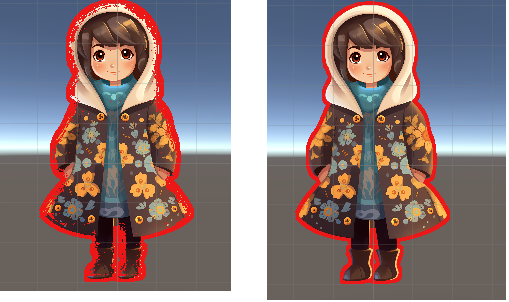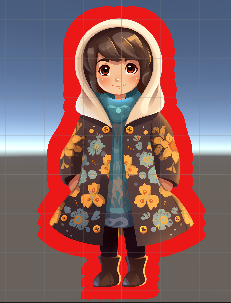1.原理
对上下左右等八个方向进行采样,然后对alpha值进行累加
在阈值以内的,那就是接近图片的边缘。
因为图片从透明区域到实体内有一个过渡。
2.代码
注意这里还是使用透明颜色混合的指令即:
Blend SrcAlpha OneMinusSrcAlpha
这个表示,混合渲染队列,放在Transparent层。
Tags { "Queue" = "Transparent" }
完整代码如下:
Shader "Custom/OutLine2D"
{
Properties
{
_MainTex ("Texture", 2D) = "white" {}
_OutlineColor ("OutlineColor", Color) = (1, 1, 1, 1) //描边颜色
}
SubShader
{
Tags { "Queue" = "Transparent" }
Blend SrcAlpha OneMinusSrcAlpha
LOD 100
Pass
{
CGPROGRAM
#pragma vertex vert
#pragma fragment frag
#include "UnityCG.cginc"
struct appdata
{
float4 vertex : POSITION;
float2 uv : TEXCOORD0;
};
struct v2f
{
float2 uv : TEXCOORD0;
float4 vertex : SV_POSITION;
};
sampler2D _MainTex;
fixed4 _OutlineColor;
float4 _MainTex_ST;
v2f vert (appdata v)
{
v2f o;
o.vertex = UnityObjectToClipPos(v.vertex);
o.uv = TRANSFORM_TEX(v.uv, _MainTex);
return o;
}
fixed4 frag (v2f i) : SV_Target
{
// sample the texture
fixed4 col = tex2D(_MainTex, i.uv);
//原始的alpha值
float originalAlpha = col.a;
float resA = 0;
for(float x = -0.01;x <= 0.01;x += 0.01){
for(float y = -0.01;y <= 0.01;y += 0.01){
//if(x == 0 && y == 0)continue;
resA += tex2D(_MainTex, i.uv + float2(x, y)).a;
}
}
resA = step(0.05, saturate(resA));
//原图中alpha为1的,让其变为0
//原本是透明的alpha为0的,变为1
resA *= (1 - originalAlpha);
/*if(resA == 0){
return col;
}else{
return _OutlineColor;
}*/
col = lerp(col, _OutlineColor, resA);//插值采样得到最后的颜色
return col;
}
ENDCG
}
}
}
效果:

左边是没进行插值的,不够平滑,也就是使用了代码
if(resA == 0){
return col;
}else{
return _OutlineColor;
}
右边进行了插值,看着就平整一点,即使用了以下代码
col = lerp(col, _OutlineColor, resA);
如果想要宽一点的线,就把采样的范围变大
for(float x = -0.04;x <= 0.04;x += 0.04){
for(float y = -0.04;y <= 0.04;y += 0.04){
resA += tex2D(_MainTex, i.uv + float2(x, y)).a;
}
}
效果:

如果想要边缘更规整,那就把采样的精度加大,即把步长缩短
但是计算量也会变大。

